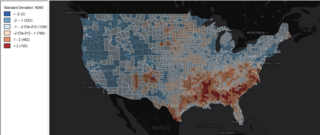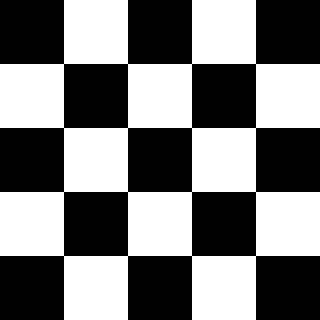Related Research Articles

Waldo Rudolph Tobler was an American-Swiss geographer and cartographer. Tobler is regarded as one of the most influential geographers and cartographers of the late 20th century and early 21st century. He is most well known for coining what has come to be referred to as Tobler's first law of geography. He also coined what has come to be referred to as Tobler's second law of geography.
William Louis Garrison (1924–2015) was an American geographer, transportation analyst and professor at the University of California, Berkeley. While at the Department of Geography, University of Washington in the 1950s, Garrison led the "quantitative revolution" in geography, which applied computers and statistics to the study of spatial problems. As such, he was one of the founders of regional science. Many of his students went on to become noted professors themselves, including: Brian Berry, Ronald Boyce, Duane Marble, Richard Morrill, John Nystuen, William Bunge, Michael Dacey, Arthur Getis, and Waldo Tobler. His transportation work focused on innovation, the deployment of modes and logistic curves, alternative vehicles and the future of the car.

Spatial analysis is any of the formal techniques which studies entities using their topological, geometric, or geographic properties. Spatial analysis includes a variety of techniques using different analytic approaches, especially spatial statistics. It may be applied in fields as diverse as astronomy, with its studies of the placement of galaxies in the cosmos, or to chip fabrication engineering, with its use of "place and route" algorithms to build complex wiring structures. In a more restricted sense, spatial analysis is geospatial analysis, the technique applied to structures at the human scale, most notably in the analysis of geographic data. It may also be applied to genomics, as in transcriptomics data.

The modifiable areal unit problem (MAUP) is a source of statistical bias that can significantly impact the results of statistical hypothesis tests. MAUP affects results when point-based measures of spatial phenomena are aggregated into spatial partitions or areal units as in, for example, population density or illness rates. The resulting summary values are influenced by both the shape and scale of the aggregation unit.
Phylogenetic autocorrelation also known as Galton's problem, after Sir Francis Galton who described it, is the problem of drawing inferences from cross-cultural data, due to the statistical phenomenon now called autocorrelation. The problem is now recognized as a general one that applies to all nonexperimental studies and to some experimental designs as well. It is most simply described as the problem of external dependencies in making statistical estimates when the elements sampled are not statistically independent. Asking two people in the same household whether they watch TV, for example, does not give you statistically independent answers. The sample size, n, for independent observations in this case is one, not two. Once proper adjustments are made that deal with external dependencies, then the axioms of probability theory concerning statistical independence will apply. These axioms are important for deriving measures of variance, for example, or tests of statistical significance.

GeoDa is a free software package that conducts spatial data analysis, geovisualization, spatial autocorrelation and spatial modeling.
Luc E. Anselin is one of the developers of the field of spatial econometrics.
Geary's C is a measure of spatial autocorrelation that attempts to determine if observations of the same variable are spatially autocorrelated globally. Spatial autocorrelation is more complex than autocorrelation because the correlation is multi-dimensional and bi-directional.

In statistics, Moran's I is a measure of spatial autocorrelation developed by Patrick Alfred Pierce Moran. Spatial autocorrelation is characterized by a correlation in a signal among nearby locations in space. Spatial autocorrelation is more complex than one-dimensional autocorrelation because spatial correlation is multi-dimensional and multi-directional.
A boundary problem in analysis is a phenomenon in which geographical patterns are differentiated by the shape and arrangement of boundaries that are drawn for administrative or measurement purposes. The boundary problem occurs because of the loss of neighbors in analyses that depend on the values of the neighbors. While geographic phenomena are measured and analyzed within a specific unit, identical spatial data can appear either dispersed or clustered depending on the boundary placed around the data. In analysis with point data, dispersion is evaluated as dependent of the boundary. In analysis with areal data, statistics should be interpreted based upon the boundary.

CrimeStat is a crime mapping software program. CrimeStat is Windows-based program that conducts spatial and statistical analysis and is designed to interface with a geographic information system (GIS). The program is developed by Ned Levine & Associates under the direction of Ned Levine, with funding by the National Institute of Justice (NIJ), an agency of the United States Department of Justice. The program and manual are distributed for free by NIJ.
A geographical cluster is a localized anomaly, usually an excess of something given the distribution or variation of something else. Often it is considered as an incidence rate that is unusual in that there is more of some variable than might be expected. Examples would include: a local excess disease rate, a crime hot spot, areas of high unemployment, accident blackspots, unusually high positive residuals from a model, high concentrations of flora or fauna, areas with high levels of creative activity, physical features or events like earthquake epicenters etc...

Arbia's law of geography states, "Everything is related to everything else, but things observed at a coarse spatial resolution are more related than things observed at a finer resolution." Originally proposed as the 2nd law of geography, this is one of several laws competing for that title. Because of this, Arbia's law is sometimes referred to as the second law of geography, or Arbia's second law of geography.
Arthur Getis was an American geographer known for his significant contributions to spatial statistics and geographic information science (GIScience). With a career spanning over four decades, Getis authored more than one hundred peer-reviewed papers and book chapters, greatly influencing GIScience and geography as a whole. The Getis-Ord family of statistics, one of the most commonly used in spatial analysis, is based on his and J. Keith Ord's work and is still widely used in the creation of hot spot maps.
Duane Francis Marble was an American geographer known for his significant contributions to quantitative geography and geographic information science (GIScience). Marble had a 40-year career as a professor at multiple institutions, retiring from the Ohio State University and holding a courtesy appointment as Professor of Geosciences at Oregon State University afterward. His early work was highly influential in computer cartography and is regarded as a significant contributor to the quantitative revolution in geography. His work on constructing a "Model Curricula" in GIScience is listed as the starting foundation built upon by the Geographic Information Science and Technology Body of Knowledge.
Michael Francis Dacey was an American geographer known for his significant contributions to mathematical models in quantitative geography. Dacey founded the department of Mathematical Methods in the Social Sciences at Northwestern University, where he served as a senior associate dean in the College of Arts and Science, as well as a professor of geography, anthropology, and geological sciences. His publications were instrumental in establishing quantitative geography in mainstream geography.
Getis–Ord statistics, also known as Gi*, are used in spatial analysis to measure the local and global spatial autocorrelation. Developed by statisticians Arthur Getis and J. Keith Ord they are commonly used for Hot Spot Analysis to identify where features with high or low values are spatially clustered in a statistically significant way. Getis-Ord statistics are available in a number of software libraries such as CrimeStat, GeoDa, ArcGIS, PySAL and R.
Wartenberg's coefficient is a measure of correlation developed by epidemiologist Daniel Wartenberg. This coefficient is a multivariate extension of spatial autocorrelation that aims to account for spatial dependence of data while studying their covariance. A modified version of this statistic is available in the R package adespatial.
Join count statistics are a method of spatial analysis used to assess the degree of association, in particular the autocorrelation, of categorical variables distributed over a spatial map. They were originally introduced by Australian statistician P. A. P. Moran. Join count statistics have found widespread use in econometrics, remote sensing and ecology. Join count statistics can be computed in a number of software packages including PASSaGE, GeoDA, PySAL and spdep.
The concept of a spatial weight is used in spatial analysis to describe neighbor relations between regions on a map. If location is a neighbor of location then otherwise . Usually we do not consider a site to be a neighbor of itself so . These coefficients are encoded in the spatial weight matrix
References
- 1 2 George Grekousis (2020). Spatial Analysis Methods and Practice. Cambridge University Press. p. 210. ISBN 9781108712934.
- ↑ Moran, P. A. P. (1950). "Notes on Continuous Stochastic Phenomena". Biometrika. 37 (1): 17–23. doi:10.2307/2332142. JSTOR 2332142. PMID 15420245.
- ↑ Li, Hongfei; Calder, Catherine A.; Cressie, Noel (2007). "Beyond Moran's I: Testing for Spatial Dependence Based on the Spatial Autoregressive Model". Geographical Analysis. 39 (4): 357–375. doi:10.1111/j.1538-4632.2007.00708.x.
- ↑ Geary, R. C. (1954). "The Contiguity Ratio and Statistical Mapping". The Incorporated Statistician . 5 (3): 115–145. doi:10.2307/2986645. JSTOR 2986645.
- ↑ J. N. R. Jeffers (1973). "A Basic Subroutine for Geary's Contiguity Ratio". Journal of the Royal Statistical Society, Series D. 22 (4). Wiley: 299–302. doi:10.2307/2986827. JSTOR 2986827.
- ↑ Getis, Arthur; Ord, J. Keith (1992). "The analysis of spatial association by use of distance statistics". Geographical Analysis. 24 (3): 189–206. doi:10.1111/j.1538-4632.1992.tb00261.x.
- ↑ Anselin, Luc (1995). "Local Indicators of Spatial Association—LISA". Geographical Analysis. 27 (2): 93–115. doi: 10.1111/j.1538-4632.1995.tb00338.x .
- ↑ Anselin, Luc (2005). "Exploring Spatial Data with GeoDa: A Workbook" (PDF). Spatial Analysis Laboratory. p. 138.
- ↑ Buckner, Anne S. M.; Khorrami, Zeinab; Khalaj, Pouria; Lumsden, Stuart L.; Joncour, Isabelle; Moraux, Estelle; Clark, Paul; Oudmaijer, René D.; Blanco, José Manuel; de la Calle, Ignacio; Herrera-Fernandez, José M.; Motte, Frédérique; Salgado, Jesús J.; Valero-Martín, Luis (2019-02-01). "The spatial evolution of young massive clusters. I. A new tool to quantitatively trace stellar clustering". Astronomy and Astrophysics. 622: A184. arXiv: 1901.02371 . Bibcode:2019A&A...622A.184B. doi:10.1051/0004-6361/201832936. ISSN 0004-6361. S2CID 119071236.
- ↑ abuckner89 (2021-07-22), abuckner89/INDICATE , retrieved 2022-09-14
{{citation}}: CS1 maint: numeric names: authors list (link)